Easy to operate combined with economy: features of a gas boiler with an indirect heating boiler
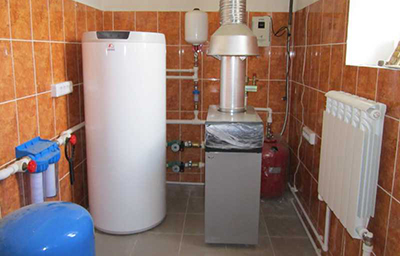
Lack of or strictly limited amount of hot water - one of the main problems of rest at the dacha or in a country house.
An indirect heating boiler may be the solution. It is not necessary to buy one right away for this purpose. dual-circuit unit. Quite you can get by with a single-circuit one, but you need to purchase an indirect heating boiler for it.
The latter dispenses the collected hot water when the owner needs to wash dishes or take a bath. It would seem that the problem is solved, but there is another serious obstacle - limited spaceIn some cases, a special room must be allocated for such a unit.
Types of gas boilers with indirect heating boiler
Gas appliances with an indirect heating boiler may differ by type of placement and shape of the tank.
By placement principle: wall and floor
There may be:
- wall-mounted;
- floor-standing.
Units first category are small-volume devices - up to two hundred liters.

Photo 1. Floor-standing gas boiler in packaging, with an indirect heating boiler, installed in a special room.
They are installed using special brackets on a stable wall that can withstand the weight of a water tank without loss. It is clear that flimsy plasterboard partitions are not suitable for this purpose. Usually such devices are purchased one small family to your private home.
Second are large capacity water heaters designed for a large number of people. Such devices will require the installation of a special boiler room.
They are usually purchased by enterprises and owners of large cottages and estates.
By the shape of the tank
- Horizontal: They are very bulky, but they do not require pumps; they themselves maintain the water in the required volume.
- Vertical: are characterized by small capacity.
When choosing, you should take into account the number of people in the family, as well as the layout features and availability of free space in the country house or house.

Photo 2. A floor-standing gas boiler installed in a boiler room and a small vertical expansion tank.
Double-circuit storage device for heating
A boiler is a tank for heating and storing water at the desired temperature, which it will then supply as needed by the owner. The simplest model: equipped with four holes a tank with reinforced and insulated walls, inside which there is a coil.
The work is carried out according to the following algorithm:
- Supply of hot water from the heating system to the coil.
- Return.
- Cold water supplied directly to the tank.
- Removing heated liquid from the tank to the tap.
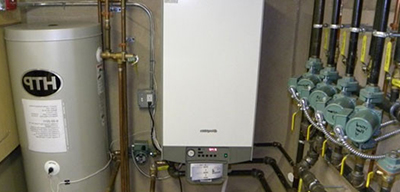
Additionally, the device includes:
- Circulation pump.
- Temperature sensor.
- Safety valve.
- Locking mechanism.
- Check valve.
- Anti-corrosion protection.
Reference! Some models provide for circulation of heated water from the boiler between the walls of the outer and inner reservoir. So, you have to wait much less for it to heat up, but also such a device costs more.
The water heater is connected to the heating system directly at the boiler parallel to the main wiring to the devices. Its own circuit allows maintaining the priority of heating in relation to the heating system. Reduces temperature spread on heating storage devices when the heater is turned on.
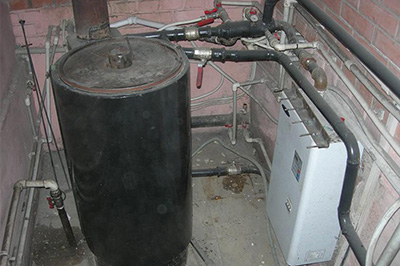
The temperature sensor detects a decrease in heat in the tank, which then sends a command to the circulation pump in the circuit.
Water from the heating system is supplied to the coil, passes through it, giving part of the energy to the still cold water already in the reservoir.
Once it has heated up to the required level, Automatic system switches off the pumpWhen you open the tap on the mixers, the incoming cold water gradually displaces and dilutes the hot water. Then the cycle repeats.
The cold water inlet is equipped with a check valve, which prevents it from draining when the pump is turned off. The pressure in the tank increases, since the mixers are not used constantly, and the water cannot flow back. Safety valve prevents the pressure from reaching a critical level by releasing a certain volume of liquid into the drain.
Important! The water heater is mounted on a flat surface next to the boiler. For suspended models, log or brick wall at the same level as the boiler or slightly higher. For floor-standing ones, a part of the space on the floor is leveled or laid on it in advance special ramp, on which the boiler is installed.
Advantages and disadvantages
To the unconditional Pros boilers with indirect heating heaters include saving on electricity.
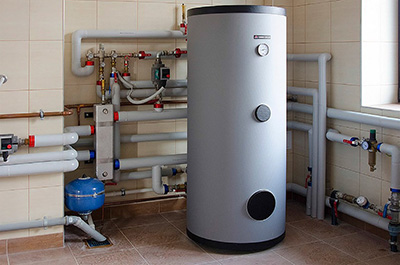
You don't need a gas burner or a power source, as with direct heating devices. The heating system does everything itself, significantly reduces financial costs.
Other advantages:
- Performance: tank, capacity in a hundred liters, gives out approximately 400 l hot water per hour.
- Almost instant hot water supply.
- Possibility of using multiple energy sources, for example, a geothermal system.
- Affordable price.
- Simplicity in design.
Cons:
- Heating speed, Even in the latest models it will not be instantaneous.
- Bulky.
Attention! If the family is quite large, then one room will have to be given over to a boiler room, pushing themselves aside. Small models will not solve the washing problem.
Recommendations
When choosing a model, you need to pay special attention to the following characteristics:
- Capacity: for two people - 80-100 l, for three - 100-120 l, four people need at least 120-150 l, five people - 150-200 l.

- Power: - directly depends on the number of users, at the same time, it should not overload the heating system's potential. According to experts, for the boiler and water heater to work properly, power is needed not less than 24 kW.
- Tank material: It is better to choose tanks made of medical or stainless steel.
- Warm-up time.
It is recommended to purchase automated version with a temperature sensor - this will make it easier and safer to use even for the younger members of the family.
Features of operation
- Pump filters require regular checking and cleaning.
- Any model requires the correct thermostat setting, Otherwise, the boiler may overheat.
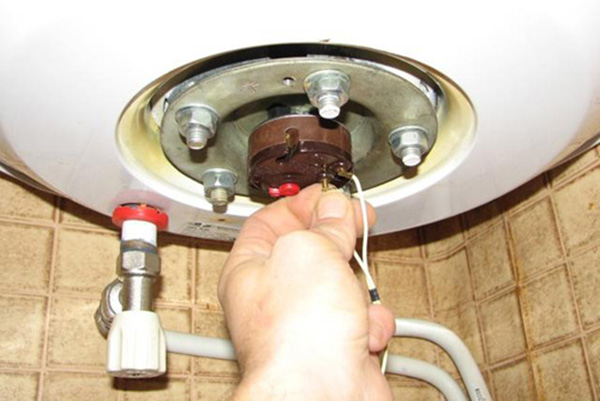
Photo 3. The technician adjusts the thermostat of a gas boiler with a water heater to avoid overheating.
- It is necessary to ensure that the temperature in the tank did not rise above the antifreeze level.
- Check anodes for corrosion. If such is found, the part is replaced. This should be done once every six months, and if the water is not hard, then once a year.
Useful video
A video in which the master talks about the operating principles of an indirect heating boiler and the intricacies of connecting the device.
Does indirect heating from a boiler solve the hot water problem?
Indirect heating boiler is good suitable for an ordinary family, where they cannot afford unnecessary expenses. He convenient and easy to handle and install. Using it is associated with minor inconveniences, for example, you will have to wait for it to warm up in any case, but the constant opportunity to live a familiar comfortable life compensates for these features.





